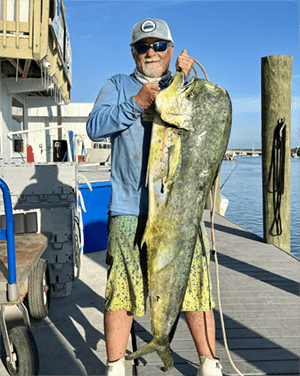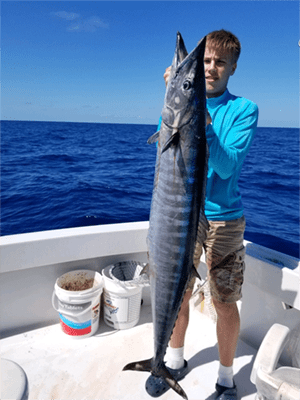
As we are heading offshore, we always let our clients know we are looking for 4 things in order of importance.
#1 any floating object bigger than a water bottle. #2 birds the bigger and blacker the better. #3 an organized weed line. #4 another boat who may have found one of the 3 things we’re looking for and do some “monkey see monkey do”.
The reason that floaters are #1 on the list is because something significant floating out in the middle of the ocean can be a home run. Something floating out in the middle of the ocean can be like finding an oasis in the desert. We often find things floating like logs, sticks, trees, buckets, barrels, boards, pallets, crab trap buoys with rope and weeds all knarled in a big clump. We’ve even found airplane wings, immigrant rafts, dead whales, and a treasure chest once.
On rough or cloudy days when we have a chance of loosing the floater, the first thing we’ll do is throw a blaze orange life jacket with a string and 1/2lb weight tied to the life jacket and throw it right on or next to the floater. We approach the floater slowly and keep our distance so we don’t spook fish that may be hanging around it, but we get close enough to throw our marker (life jacket) to it with the wind at our back for more distance. We also get close enough to look around it to evaluate what kind of gamefish we see. A boat tower helps a lot in this situation.

Our first troll is 40 or 50 yards away from the floater. If we get hit, we keep that same distance on every troll until we don’t get hit. Each troll by we get closer and closer if we don’t get hit until we’re practically trolling our Ballyhoo directly over the floater. Once we’ve trolled past it a few times without a hit, then we’ll stop the boat, reel in the trollers and switch to pitch rod n reels. Sometimes we troll past it 30 times before we stop and switch to pitch rod n reels because we caught fish on all 30 passes, but after a while the gamefish seem to get educated and stop hitting. It doesn’t necessarily mean that there’s no more gamefish left or they are full, it can just mean they got educated and they may bite on another type of presentation.
When we decide to stop and pitch rather than troll, we’ll drift casting range away from the floater. Before we cast, we’ll typically chum. Things we chum with are live pilchards, live pinfish, live ballyhoo, live goggle eyes or chunks of ballyhoo or chunks of squid depending on what type of gamefish we see around the floater.
For example, if we spot a tripletail or multiple tripletail we’ll quickly evaluate if there are any keeper tripletail in the mix (16 inches or bigger). If we do identify a keeper, many times there’s a bunch of juvenile bar jacks and triggerfish swarming around the floater. Many times if we cast a hooked squid, chunk of ballyhoo or shrimp to the tripletail the jacks and triggers will get to the bait before the slow moving tripletail will get to it, so we’ll throw a bunch of chum away from the floater to get the swarm of jacks and triggers away from the floater and away from the tripletail and at that time we present the hooked bait right to the face of the tripletail and wait until the tripletail sucks the bait it and set the hook.

Once we’ve caught all the gamefish we want to catch by trolling and pitching, we’ll end the floater encounter with a last shot at wahoo. We’ll have an angler or two deep drop vertical jigs directly under the floater and count to 100 Mississippi before stopping the jigs dissent. Then we have them violently jig jig reel, reel reel jig, all the way back up to the surface. We’ll do it 2 or 3 times without getting a hit until we quit.
Depending on how long the floater has been floating there’s a whole eco system going on under that floater that we can’t even see. What we are primarily targeting while vertical jigging under the floater is wahoo or Amber Jack since we are targeting wahoo we put a 6-inch 50 pound wire liter between the mono and the vertical jig. If we don’t get a game fish to hit vertical jigging, we’ll typically drop down to vertical jigs on either side of the floater count 100 Mississippi again, then flip the bail closed and drive off at 15 knots from the floater and wait for the hit. after exhausting all of the techniques we use to catch gamefish around the floater, we may even high-speed troll past it a timer two before leaving it totally.
On a good floater it’s not rare for us to catch three or four different species and a bunch of them. That’s why we list floaters as the top thing to find while offshore fishing. Good luck and be safe!
— For a charter with Captain Joel or Jojo Brandenburg of Ana Banana Fishing Company in
Marathon Florida Keys call cell 813-267-4401 or office 305-395-4212 or
visit www.marathonkeyfishingcharters.com or visit us in person at Ana Banana Marina located at
11699 Overseas Hwy Marathon Florida Keys. Look for the big yellow Ana Banana sign with antlers around it.
